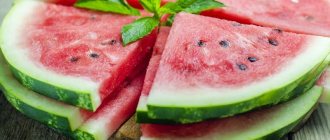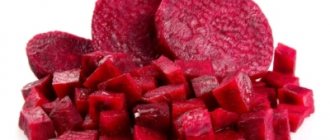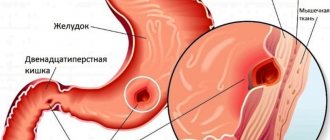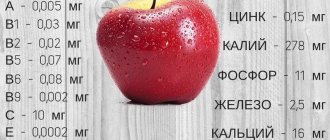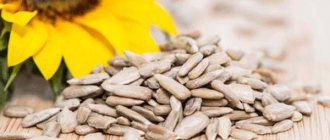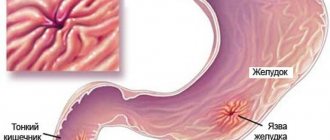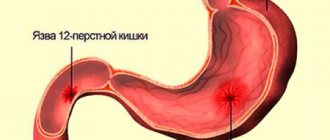Vegetables in various forms make up a significant part of the human diet. But if you have a peptic ulcer, you need to know which vegetables you can eat, and which ones you should avoid eating altogether or limit the amount of them in your diet. After drug treatment of a stomach ulcer has been carried out, the gastroenterologist must definitely focus the patient’s attention on what foods can be eaten, because it is following a diet that allows long-term remission to be achieved.
- Forbidden vegetables
- Allowed vegetables
- Cooking tips
In general, to better understand which vegetables you can eat, you should use the “green, yellow and red” rule: you can eat green and yellow vegetables, but you should not eat red vegetables.
Are vegetables allowed for ulcers?
Plant foods are important for the body to function properly. Garden crops are rich in beneficial microelements, valuable minerals and vitamins. In addition, such products contain pectins, which protect the gastric mucosa from negative effects and have the following effect:
- beneficial substances that get inside bind toxins and remove them from the intestines;
- microflora is normalized;
- the processes of fermentation and decay are inhibited;
- intestinal motility improves;
- the cleansing process is accelerated.
Important: If you stop eating vegetables, the patient will experience increased gas formation and flatulence. Therefore, vegetables for stomach ulcers must be included in the menu.
However, it should be noted that not all vegetables are beneficial for ulcers. Some cause irritation of the mucous membrane and increase the secretion of gastric secretions. In addition, such products should be completely excluded from the diet in fresh form in case of exacerbation of ulcer pathology.
Features of nutrition for stomach and intestinal ulcers
For stomach and duodenal ulcers, nutrition is changed in a comprehensive manner.
They consider not only the diet, highlighting prohibited and permitted dishes, but also eating habits. For example, when drawing up a menu for the day, patients take into account the time it takes to digest food. Porridge, baked goods and boiled vegetables are processed quickly by the body: within 5 hours. Meat, fish and legumes take 5 hours to digest, so they try not to eat them at night. Fruits should not be eaten with protein products: the former inhibit the functioning of the gastrointestinal tract and cause rotting of the latter. In case of a peptic ulcer, foods that overload the stomach and irritate the mucous membranes are excluded from the diet. First of all this:
- fried meat, poultry and fish;
- rich soups;
- horseradish, turnip, raw onion;
- mushrooms;
- marinades, pickles and smoked meats;
- sauces;
- seasonings;
- fatty dairy products;
- fresh white and black bread;
- baking from butter and puff pastry;
- coffee;
- alcohol;
- carbonated drinks.
Fried meat, fish, and mushrooms should not be consumed if you have a peptic ulcer.
The menu consists mainly of soups in vegetable broths, cereals, fruits and vegetables. The diet includes lean meats. You can use non-acidic kefir, cottage cheese and yogurt. It is allowed to prepare dishes based on them. Drinks include diluted non-acidic juices, weak tea with milk and rosehip decoction.
The admissibility of including tomatoes in the menu is determined individually, since they can cause both harm and benefit.
Benefits and harms
People with ulcers should not completely exclude their favorite red vegetable from their diet. Tomatoes have many healing properties, which are provided by its constituent vitamins, purines, leucopene and other macro- and microelements useful for the human body. The product is low in calories, so it is great for people who are concerned about excess weight. The vegetable also has other beneficial properties, namely:
- increases the production of urine and bile;
- eliminates digestive problems due to the ability to regulate metabolic processes;
- prevents the formation of blood clots and has a positive effect on the composition of blood fluid;
- normalizes blood pressure.
In the collection of folk recipes there is another effective remedy that helps with ulcers. To prepare it, you will need to mix 200 g of pumpkin puree with a small amount of butter and 2 glasses of tomato juice. It is allowed to add a little salt to the dish, then mix thoroughly and drink in the morning and evening half an hour after the meal. The duration of taking the medication is 5-6 weeks with weekly breaks of 5-7 days.
Diet principles
What postulates should be followed when preparing a dietary diet?
- Balance. The patient's daily menu should be varied, and its total energy value should be at least 3000 calories.
- Minimum portion size. To avoid overloading the damaged organ, a single meal should not exceed 150 grams (fit in the palms of your hands).
- Avoiding foods that increase gas formation.
- Fractionality. Breaks between meals vary in the range of 2 - 3 hours.
- Minimize salt intake.
- Prohibition on fried, spicy, fatty, smoked products, marinades.
- Increasing the amount of water you drink to 2 liters per day, provided there are no diseases of the urinary system or thyroid gland.
- Prohibition on cold and hot food. Dishes with temperatures up to or above 30 degrees slow down the restoration of epithelial tissue of the stomach and inhibit the function of enzyme secretion.
- Priority is given to gentle food that does not irritate the already inflamed walls of the stomach. Acceptable variations in the heat treatment of dishes: steaming, stewing, boiling, blanching.
- Refusal of foods that stimulate the production of gastric juice.
- The principle of zigzag nutrition. The essence of the method is to train the gastrointestinal tract. It implies that for a short period of time the patient is allowed to consume foods from the prohibited list (within reasonable limits), and then follow the diet menu again. This principle is practiced only at the recovery stage.
- Tracking the time it takes to digest food. Liquid in the body is retained in the stomach for 0.5 - 1.5 hours. Boiled vegetables, baked goods, and cereals take up to 3 hours to digest. And legumes, meat and fish load the digestive tract for 5 hours. At the same time, fruits eaten as part of the main meal, together with other food products, inhibit the absorption of the latter, which leads to food rotting. In this regard, they are recommended to be consumed exclusively in between meals.
- The principle of individuality. When composing your diet, take into account the characteristics of the disease and the body. If there is an individual intolerance to an approved product, it is excluded from the diet.
The main goal of nutrition for ulcers is to normalize the digestion process and accelerate the regeneration of the mucous membrane that lines the stomach.
To improve the patient’s condition, the diet must be followed for at least 1 year after an exacerbation of the pathology. Only in this case is it possible to permanently heal defects in the gastric mucosa and prevent repeated cases of exacerbation of the disease.
What vegetables are allowed during an exacerbation period?
What vegetables can you eat if you have an ulcer during an exacerbation? The ulcer menu for the disease in question includes food that does not cause intestinal irritation. In addition, it is important that foods do not provoke an increase in hydrochloric acid. These include:
- potato;
- zucchini;
- carrot;
- pumpkin;
- some varieties of cabbage, except white cabbage;
- greenery.
This plant food has healing properties: it heals wounds, enriches the body with useful microelements, improves immunity and speeds up the healing process. However, so that vegetables do not provoke an aggravation, they are subject to heat treatment.
Potato
Potatoes are recommended for stomach and duodenal ulcers, not only when they fade, but also when they are severe. This root vegetable contains many beneficial vitamins. In addition, potato tubers are rich in carotene, organic acids and microelements. But in order to benefit from this culture, it is important to know how to prepare it correctly:
- in case of exacerbation of the disease, it is strictly forbidden to fry and consume root vegetables;
- potatoes may be baked in their own skins;
- You can also prepare puree in water or eat it boiled.
Potatoes do not cause an increase in acidity, block inflammation and eliminate cramps. In addition, the root vegetable contains fiber that does not provoke intestinal irritation and does not have a stimulating effect on peristalsis. But it should be noted that when the defect worsens, potatoes are consumed only warm.
Broccoli
Broccoli is also useful for duodenal ulcers. It is rich in folic acid, contains many useful trace elements and salt. Moreover, this culture contains a number of valuable vitamins that have an antiulcer effect and inhibit the activity of the main causative agent of pathology, Helicobacter.
In addition to broccoli, other varieties of cabbage are also indicated for ulcerative defects affecting the gastrointestinal tract:
- colored;
- Beijing;
- sea and pickled in small quantities.
As for white cabbage, it is not advisable to add it to your diet. Since this garden crop promotes the active production of acidity and gas formation. This food of plant origin is allowed only when the pathology subsides, in a small volume.
But cauliflower will only bring benefits. Healthy purees and soups are not prepared from it. At the same time, it is better to cook dishes from the inflorescence. Since the leaves negatively affect the mucous membrane, damaging it.
As for stewed or salted cabbage, such dishes are prohibited. Excessive consumption of sauerkraut and seaweed will also do more harm than good. Therefore, during an exacerbation, it is recommended to introduce such dishes into the diet in moderation.
Carrot
Carrots will also be useful for stomach ulcers in the acute stage. It contains vitamins and useful minerals. It should be noted that only boiled and ground fruits are allowed for consumption. Since the culture in its raw form promotes the production of gastric secretions.
In case of ulcerative exacerbation of the intestines, the root vegetable is added to the diet in small quantities. And when remission occurs, gastroenterologists recommend regularly drinking freshly squeezed juice as a preventative measure.
Pumpkin
If you have an aggravated stomach ulcer, you can add pumpkin to the menu. This garden crop is considered a real storehouse of the following substances:
- vitamins B, C and A;
- measure and copper. By the way, these elements are difficult to find in other vegetables;
- cellulose;
- potassium and carotene.
In case of ulcerative exacerbation, it is allowed to eat baked, boiled or stewed pumpkin. At the stage of exacerbation, pumpkin juice mixed with acacia honey is useful.
Important: For ulcerative exacerbations, gastroenterologists allow you to drink pumpkin juice 40 minutes before meals. This allows you to eliminate pain and alleviate the course of the pathology.
The main advantage of pumpkin: the ability to inhibit the production of gastric secretions, normalize digestion and eliminate inflammation of the mucous membrane. Also, the product does not affect peristalsis.
Zucchini
There is a list of vegetables that are indispensable for ulcerative pathology. One of these is zucchini. This dietary garden crop is rich in the following components:
- vitamins B, C and E;
- potassium;
- iron.
In addition, this fruit contains components that block the development of malignant tumors, eliminate inflammation and normalize gastrointestinal motility. But it is necessary to highlight that in case of an ulcer, zucchini can only be consumed boiled, stewed or baked. Because raw fruits help increase the production of hydrochloric acid.
Greenery
Greens are very beneficial for the human body. For ulcer sufferers, the use of these plants is mandatory. The permitted ones include the following:
- Salad. The culture is rich in carbohydrates, vitamins and fats. In addition, this plant-based crop contains phosphorus, calcium, iron and potassium. Due to this composition, the salad is recommended fresh for ulcers. The juice of this plant is also useful;
- Celery. An indispensable culture for the disease in question. Celery contains vitamins, oxalic acid, purines and essential oils. These elements activate the healing of erosions and create a film that protects the mucous membrane from the effects of hydrochloric acid;
- Dill. It is recommended to introduce the plant into the menu in case of exacerbations in small quantities. Dill contains phosphorus salts, magnesium, calcium, potassium and vitamin C. Regular use of the culture during the attenuation of pathology helps prevent exacerbations and accelerates the healing of wound areas;
- Parsley. When an ulcer worsens, parsley is also recommended to be added to the menu. This plant contains carotene, beneficial microelements and vitamins. The culture promotes mucosal healing. Therefore, it is recommended to consume it on an empty stomach 30-40 minutes before meals.
Depending on the course of the defect in question, the patient’s menu is expanded with other equally useful crops. However, it is better to discuss this issue with your gastroenterologist.
Diets for ulcers
For effective treatment of ulcerative pathology - restoration of failure of the digestive process and regeneration of stomach tissue, patients are prescribed diet No. 1a (during an exacerbation for 10 - 20 days, depending on the patient’s condition), then switch to a more advanced version No. 1 or 5 (at the stage of remission ), at the discretion of the attending physician. In any case, to improve your health, the prescribed diet must be strictly followed, without making independent adjustments.
Diet No. 1
Prescribed to patients at the stage of subsiding exacerbation, restoration of the mucous membrane.
The duration of diet No. 1 varies from 3 to 5 months, and the calorie content of the daily diet reaches 3000 calories. This method of eating involves eating boiled or steamed dishes, ground into a homogeneous mass. In this form, products do not have a mechanical effect on the walls of the stomach and are quickly digested without loading the digestive tract. The ratio of B (proteins) : F (fats) : Y (carbohydrates) of the daily menu should correspond to 5 : 1 : 1, and the frequency of meals should occur every 2 – 3 hours.
The diet menu consists of the following products: lean boiled meat, yesterday's baked goods, egg whites, unleavened biscuit, milk soup, pureed cereal porridge, pudding, vegetable puree, small vermicelli, non-sour cottage cheese, sour cream, milk. For dessert, you are allowed to eat boiled or baked sweet fruits (strawberries, pears, apples).
Diet No. 1a
It is prescribed during an exacerbation of peptic ulcer disease, in which bed rest is a prerequisite.
This is a strict subtype of diet No. 1. To soothe the irritated gastric mucosa, foods that increase the production of gastric juice are excluded from the patient’s diet. When using diet No. 1a, food is taken in small portions up to 8 times a day. The ratio B: F: Y is 0.8: 0.8: 2, and the energy value of the diet should not exceed 2000 calories per day.
The consumption of vegetable dishes and bread is prohibited. The basis of the diet is slimy soups and porridges (from rice, semolina, oatmeal), milk, butter (in moderation), lean fish and meat, soft-boiled eggs. You can use berry jelly, fruit soufflé, honey, and jelly in your diet.
Before serving, the dishes are rubbed through a sieve to avoid injury to the walls of the stomach.
Diet No. 5
Designed for proper nutrition of the patient after the symptoms of an exacerbation have been relieved, during the recovery stage. Diet No. 5 creates favorable conditions for the normalization of the digestive tract and implies the consumption of balanced foods. Exceptions: fried foods, fats (refractory), foods rich in essential substances (ginger, garlic, onions), cholesterol-forming food components, mushrooms, radishes, sorrel. The preferred processing method is still: boiling, baking in the oven, steaming.
You can include sweet vegetables and fruits, dried bread, biscuits, cheesecakes, cabbage soups, tongue, aspic, and non-spicy hard cheese in your diet.
For peptic ulcer disease, the use of herbal decoctions based on linden blossom, yarrow, St. John's wort, chamomile, plantain, fennel, marshmallow, and licorice is encouraged.
To coat the stomach and reduce the aggressive effect of gastric juice on the inflamed walls, it is recommended to take 100 milliliters of flax seed jelly daily 30 minutes before meals.
Remember, a diet for ulcers cannot replace the main treatment, but it plays an important role for the human body: it accelerates the healing of eroded areas and prevents complications.
Consequences of frequent use
Everything is good in moderation. This also applies to tomatoes.
Persons suffering from diseases of the digestive tract need to be extremely careful with these vegetables, and certainly should not abuse them.
The effect of organic acids that make up tomatoes:
- irritate mucous membranes;
- prevent the healing of erosions and ulcers;
- increase acidity;
- contribute to the occurrence of symptoms of dyspepsia - heartburn and sour belching.
When an ulcer worsens, tomatoes aggravate pathological processes and interfere with the restoration of the mucous membrane
Science has described cases where, against the background of excess lycopene contained in vegetables and juice, the patient’s skin turns orange. Lycopenoderma develops. This condition is low-risk, but unaesthetic. After giving up foods containing lycopene, skin color returns to normal.
What vegetables are allowed during remission?
During the period of attenuation of the disease, the list of permitted vegetables can be expanded. Doctors often allow the following crops to be eaten:
- beet;
- cucumbers and tomatoes;
- onion;
- bell pepper
These fruits help increase the production of gastric juice. Therefore, they need to be treated with caution and gradually introduced into the diet. However, plant foods cannot be completely eliminated. Since each culture is rich in microelements and other beneficial substances for the body.
Beet
Beetroot for stomach ulcers is indicated in the attenuation stage of the pathology. During severe cases, this product is avoided. Because in addition to useful elements, beets contain a large amount of natural acids.
Beetroot is prescribed for duodenal ulcers as a preventive measure. The most suitable for consumption is beet juice with acacia honey. Take the drug in courses.
Another question that interests many people suffering from gastrointestinal problems is whether it is possible to eat raw beets for stomach ulcers. The most suitable for consumption would be boiled beets or juice squeezed from them. However, if you want to eat the crop raw, its consumption is indicated in small quantities.
Cucumbers and tomatoes
Is it possible to eat fresh cucumbers and tomatoes if you have a stomach ulcer? These vegetables are strictly contraindicated during an exacerbation. It is permissible to eat cucumbers for stomach ulcers only during remission, observing the following rules:
- fruits are eaten only fresh;
- eat cucumbers in small quantities, after removing the peel;
- It is better to add the culture to other dishes.
As for the question of whether tomatoes are allowed for stomach ulcers, everything is not so simple. Tomatoes activate the production of gastric secretions, have a negative effect on the intestines, block the healing of wound areas and provoke inflammation. In addition, this fruit negatively affects the functioning of the pancreas.
In general, gastroenterologists allow the consumption of tomatoes only during remission, in small quantities. with pre-peeled skin.
Onion
In the fight against the disease in question, onions are also allowed, but only for the attenuation period. They eat it boiled, combining it with other dishes. Onions are rich in flavonoids and have a good antimicrobial effect. In view of this, it will be indispensable as a preventive measure.
bell pepper
Bell peppers should be completely excluded during an exacerbation period. Because this vegetable helps increase the secretion of gastric secretions. But at the moment of attenuation of the pathology, the fetus is allowed due to a number of beneficial properties:
- pepper contains substances that block the development of malignant tumors;
- the fruit is considered one of the powerful antioxidants of natural origin;
- The culture is endowed with good antibacterial properties, due to which it is able to inhibit the atypical activity of Helicobacter.
Important: When the ulcer subsides, it is allowed to add a little garlic to dishes as a seasoning. It is prohibited to consume this crop without preliminary heat treatment.
By adhering to the diet developed by a gastroenterologist, it will be possible to speed up the healing process of erosions that have affected the mucous membrane. At the same time, it is important to remember that you need to eat foods of plant origin in small quantities in order to prevent exacerbation in the future.
What a ulcer this is! Nutrition for peptic ulcers
Nutrition for peptic ulcers, as for other diseases of the digestive system, is one of the most important elements of therapy. Some products, due to their properties, are able to restore damaged gastric mucosa. But there are also those that irritate the walls of the inflamed stomach and can lead to an exacerbation of the disease.
Causes of ulcers
The walls of the stomach of a healthy person are covered with a mucous membrane that protects them from the action of hydrochloric acid produced by the stomach to digest food.
When the balance between the protective mechanisms of the stomach and aggressive factors is disrupted, the mucus can no longer cope with enzymes and hydrochloric acid, and damage (erosions) appear on the mucous membrane, which then develop into ulcers.
The most common cause of ulcers (in 75% of cases) is Helicobacter pylori infection.
Helicobacter pylori bacteria are able to neutralize hydrochloric acid produced in the stomach, and therefore live and reproduce safely in an environment that is aggressive for other bacteria. Parasitizing in the stomach, the bacterium destroys the cells of its mucous membrane, causing gastritis and ulcerative processes.
An ulcer can be triggered by taking certain medications (aspirin, diclofenac, ketoprofen, ibuprofen, etc.). It can be a complication of diseases such as diabetes mellitus, liver cirrhosis, and thyroid pathologies. Stress, poor diet and bad habits (especially smoking) are also causes of ulcer development. Men are more likely to suffer from stomach ulcers.
General principles of nutrition for ulcers
In the prevention of peptic ulcer disease, diet is of great importance. Meals should be frequent (5 times a day), and the portion should be equal to the volume of the palm. The break between meals should not exceed 2.5 hours. If by this time food does not enter the stomach, gastric juice begins to eat away at the ulcer, causing it to increase in size, which threatens bleeding or perforation of the ulcer.
The diet for ulcers should be balanced and high in calories (about 3000 kcal per day). 60% of it should be proteins, since they contribute to the repair (healing) of the ulcer; 30% - vegetable fats to improve mucus formation; 10% - carbohydrates.
At the first pain symptoms, food is taken in puree or liquid form.
Dishes need to be prepared by stewing or boiling in water or steaming. Food should not be too hot or cold. Foods heated to temperatures above 30 °C can inhibit the formation of enzymes and slow down the restoration of stomach tissue.
What should be excluded?
- Fried, baked until golden brown, as well as all types of smoked meats, canned foods and pates.
- Rich meat and fish broths in the first water, as well as okroshka and cabbage soup with sauerkraut.
- Fatty meats (pork, lamb, duck, goose) and fish, as well as lard and caviar.
- Dairy products with acid (kefir, ayran, tan), dairy products with a fat content of more than 10%, condensed milk and cheeses.
- Hard-boiled and scrambled eggs.
- Barley, rice, corn, bran and muesli.
- Vegetables that contain hard-to-digest fiber: radishes, radishes, turnips, peas, beans, rutabaga. All types of cabbage.
- Cucumbers, tomatoes and tomato paste, especially during an exacerbation. During the remission stage, they can be consumed little by little in crushed form, without the skin.
- Black bread.
- Salt. It retains fluid, slowing down the recovery process of the gastric mucosa.
- All carbonated drinks, alcohol.
At the time of exacerbation of the ulcer, exclude foods that can irritate the gastric mucosa: garlic, onions, spices, sorrel and rhubarb, sour berries and fruits (watermelons, oranges, tangerines, lemons, pineapples, gooseberries, currants), grapes, dried apricots, apricots, nuts , seeds, dried fruits, various sauces (ketchup, mustard, mayonnaise, horseradish, vinegar, and sauces with chili peppers). In the first days of an exacerbation, you should not drink coffee and tea. To relieve pain, you can drink one cup of coffee with milk per day.
Recommended Products
- Day-old wheat bread, baked goods made from unleavened dough, but in small quantities filled with apples, fish or lean meat.
- Rusks, unsweetened cookies.
- Milk soups with the addition of cereals or pasta. Fermented milk products: Varenets, fermented baked milk. Cottage cheese in the form of casserole, mousse, cream. Fresh cheeses.
- Meat soups on second water. Low-fat fish.
- Main courses of rabbit, turkey, chicken, beef, veal, prepared in the form of meatballs, cutlets or steamed meatballs, soufflé.
- Soft-boiled eggs or as an omelet.
- Hercules, semolina and buckwheat porridge.
- Fruits (apples and pears) are best baked. And on days of exacerbation, grind it into puree.
- Marmalade, honey, marshmallows, marshmallows, jam.
- Refined olive oil in small quantities.
Be sure to increase your water consumption to 2 liters per day, provided that you do not have a disease accompanied by edema. Useful drinks include rosehip decoction, juices half diluted with water, weak tea, compote, and cocoa.
Does baking soda help with ulcers?
Baking soda does neutralize the effect of hydrochloric acid, but for a very short time. As soon as the soda leaves the stomach, moving to the duodenum, a new, even larger portion of hydrochloric acid is produced in the stomach.
In addition, when soda interacts with hydrochloric acid, carbon dioxide is released, which presses on the walls of the stomach, which can cause perforation (rupture) of the ulcer. Thus, using soda for ulcers is strictly prohibited.
How to cook
The most correct way to cook cucumbers and tomatoes, and not face unpleasant consequences, is to boil them. This treatment destroys some of the organic acids, so boiled vegetables are acceptable for patients. Also, for pathologies of the small intestine, soups are usually recommended - in them, harmful substances are partially destroyed and dissolved in the broth.
The second way you can cook cucumbers and tomatoes is stewing. In stewed vegetables, acids are also destroyed, as in soup. The main thing is not to overdo it with seasonings - most of them are not allowed for the patient. The trouble is that recipes for stewed, baked and boiled cucumbers and tomatoes have a specific taste.
You can make soup from tomatoes
How not to cook vegetables:
- salt;
- marinate;
- fry, including over an open fire.
In vegetables processed in this way, new, even more aggressive compounds are formed, and the amount of acids increases. This especially affects pickled cucumbers and tomatoes.
Prohibited Products
An ulcer is a dangerous disease that requires long-term treatment. For successful therapy and restoration of the patient’s health, food that irritates the gastric mucosa, which takes a long time to digest, increases gas formation, and contains a large amount of salt, is excluded from the patient’s diet.
What should you not eat?
- Sauerkraut cabbage soup, okroshka.
- Smoked products, sausages. The exception is ham in moderate quantities (up to 70 grams per day).
- Rich meat and fish broths, soups based on them.
- Dairy products with acid (tan, ayran, kefir).
- Cucumbers, tomatoes, tomato paste.
- Mushroom dishes.
- Fatty meat, fish, lard, caviar.
- Vegetables with a high fiber content, which make it difficult to digest food: peas, beans, rutabaga, white cabbage, turnips, radishes, radishes.
- Cereal side dishes from corn, wild rice, pearl barley, bran granules, muesli.
- Canned foods, including pates.
- Fatty dairy products: cream, cheeses, condensed milk, whole milk, buttermilk.
- Sour berries and fruits: lemon, orange, lime, gooseberries, figs, grapes, pineapple, tangerine, currants.
- Hard-boiled eggs.
- Products of plant origin that irritate the gastric mucosa: garlic, onion, sorrel, rhubarb.
- Salty, spicy sauces: ketchup, vinegar, mustard, horseradish.
- All carbonated drinks.
- Pastries, rye bread.
- Ice cream and chocolate.
- Alcohol, tea, coffee, cocoa.
- Dried fruits, nuts, apricots.
When processing meat, veins and cartilage are removed from it, which are difficult to digest and burden the digestive tract.
In what form is it best to consume?
Introducing permitted fruits into the diet is required in compliance with certain measures:
- In case of acute ulcerative pathology, only potatoes are allowed in their raw form. As for other permitted garden crops, they are eaten only after heat treatment. Can be boiled, stewed, baked or steamed;
- If the defect is chronic, it is permissible to eat root vegetables raw. However, the peel should be removed before consumption. In addition, such food is cut into small slices and eaten in small portions;
- In case of ulcerative defect, canned vegetables, salads with mayonnaise and vinegar are strictly prohibited;
- It is recommended to eat meals often and not in large quantities. At the same time, it is advisable to limit yourself to a glass of kefir or an apple at night. Because at this time of day the work of the stomach slows down. As a result, food is not processed;
- Even during the period of attenuation of the disease, spices cannot be included in the menu. Such products provoke an exacerbation, accompanied by pain, nausea and vomiting.
Important: Ulcer sufferers should definitely purchase a double boiler. This device allows you to prepare delicious dishes without adding oil and losing all the beneficial properties.
Vegetables are important and healthy. But you should eat them little by little in order to avoid dangerous health consequences. In addition, if side effects occur, it is necessary to exclude the culture that provoked this condition from the diet and immediately consult a gastroenterologist for advice.
Which vegetables are ok for gastritis and which are not?
With gastritis, the walls of the stomach or intestines are damaged, resulting in ulcers and bleeding. A diet high in fiber (fiber) will help prevent complications caused by this disease, but it's not that simple.
“Many fresh vegetables are high in fiber, making them dangerous for people with gastritis due to increased gas production and abdominal pain,” says Sharon Richter, a registered dietitian in New York City.
If you have gastritis, it is extremely important to consult your doctor about permitted and prohibited foods. We can only give you a rough list of soft fiber vegetables to consider.
But dietary fiber isn't the only thing a vegetable diet can offer your digestive tract. As is known, the cause of gastritis, gastric ulcers and gastrointestinal cancers is the notorious bacterium Helicobacter Pylori. It has a spiral shape, due to which it is embedded in the walls of the gastric mucosa. Raw vegetables contain antioxidants that can attack these dangerous bacteria.
When color matters
Orange
In addition to fiber, they contain beta-carotene, an antioxidant that protects the gastric mucosa from the development of erosive gastritis.
Best choices: pumpkin, squash, carrots, yellow peppers, yellow tomatoes, sweet potatoes and corn. Again, some of the listed foods, when consumed raw, provoke flatulence.
Reds
They protect the body not only from gastritis, but also from certain types of cancer.
The undisputed leaders in this group are beets and red potatoes. They are the safest and are easily tolerated by the digestive system.
But red cabbage, red peppers and radishes can cause gas, so it is better to exclude or reduce their consumption to a minimum.
Do not include tomatoes or tomato juice in your menu. They contain acids that irritate the walls of the stomach and intestines. With gastritis, additional stress for the digestive system is completely unnecessary.
Greens
Digestion of the most popular green vegetables is usually accompanied by the release of large amounts of stomach acids.
Use Brussels sprouts, artichokes, asparagus, green peppers, green beans and green onions only after cooking. These vegetables should not be eaten raw.
Keep a diary in which you will record your body's reactions to a particular product. The notes will help you ultimately create the ideal treatment menu and avoid unpleasant symptoms.
Purple
If you have gastritis, you can also eat purple-colored vegetables. They will not only help cope with this disease, but also help prevent cancer, heart disease, and stroke.
Worthy representatives of the group: purple carrots, potatoes, onions and peppers, eggplant, Belgian endive with purple leaves.
But it is better to avoid purple varieties of asparagus and cabbage for the same reason - a high probability of flatulence and irritation of the tissues lining the stomach and intestines.
White
Parsnips and potatoes can form the basis for a healthy diet for those suffering from gastritis.
Limit your consumption of turnips, cauliflower and onions. You will most likely feel discomfort from them.
The healing power of broccoli
According to the Japan Times, Japanese scientists conducted an important experiment that reveals new facets of the beneficial properties of broccoli. Remarkably, residents of the Land of the Rising Sun are 6 times less likely to suffer from stomach cancer than Americans. But among them there are also lovers of salty foods and smokers. One likely reason is the large amount of fresh vegetables in the average Japanese diet, such as broccoli.
Akinori Yunaka from the University of Tsukuba conducted an interesting experiment. 20 people consumed 100g of broccoli sprouts daily, which are rich in an antioxidant called sulforaphane glucosinolate (250mg per serving). This compound blocks carcinogenic substances, i.e. those that cause cancer.
After two months of treatment, all patients participating in the study had a decrease in the amount of Helicobacter Pylori and the pepsinogen enzyme in their bodies, a marker that signals damage to the gastrointestinal mucosa.
Thus, fresh broccoli can become a faithful assistant in the fight against gastritis and other dangerous diseases of the digestive system.
Controversial cucumbers
- “Even though cucumbers contain soft fiber, they can also cause stomach irritation and make illness worse for some people.” So says Doctor of Medical Sciences John McDougall, founder of the School of Proper Nutrition in the USA.
- Doctor of natural medicine and fellow of the Association of American Physicians Jeff Warber says that cucumbers, on the contrary, can be used as a preventative healing agent in patients with gastritis. The fact is that this vegetable has a slight alkalizing ability.
Unfortunately, there have been no reliable clinical studies confirming one of the mentioned points of view. Therefore, only you yourself will make the decision, based on the reactions of your body.
How much is this in grams?
The optimal amount of vegetables you should consume per day largely depends on the individual characteristics of your body.
The average norm for an adult is 3-4 servings per day. This is approximately 1 bowl of fresh raw vegetables, ½ bowl of boiled vegetables, 2 bowls of green salad or half a glass of vegetable juice.
You can eat boiled, stewed, steamed or baked vegetables. Frying is not recommended. It is forbidden to use hot spices. Avoid mustard and hot pepper. Onions and garlic cause burning and pain in the abdominal area in many people suffering from chronic gastritis.
To help your gastrointestinal tract, chop or juice raw vegetables before eating. Let the blender and juicer do the extra work for your stomach and intestines. Chew dishes made from boiled or baked vegetables thoroughly.
In fact, the list of products useful for gastritis is much wider, but many of those that are left outside the scope of this article cause conflicting reviews from patients. For example, some herbalists advise using ginger or aloe juice in the treatment of illness. However, not everyone tolerates such folk therapy well.
In conclusion, I would like to note that vegetables alone cannot cure this disease. It is necessary to completely reconsider your lifestyle: give up bad habits, choose foods for your diet more carefully, do not get carried away with medications without a doctor’s prescription, etc.
Treatments for gastritis can also include herbs, acupuncture, homeopathic remedies, probiotics, vitamins, and foods high in fatty acids. Only comprehensive treatment can bring results.
Why do you need a diet for chronic pancreatitis in adults and how to follow it
Strict adherence to a certain diet for chronic pancreatitis in adults is an important part of the treatment process. What kind of disease this is, why it is dangerous and why such drastic measures need to be taken, this article will tell you.
What is pancreatitis
Pancreatitis is a progressive disease of the pancreas, in which in the acute period an inflammatory process is observed with subsequent changes in the tissues of the organ itself. This occurs due to the replacement of the normal structure with connective tissue. The consequence of such processes is disruption of the functioning of the pancreas and the development of enzymatic deficiency.
Pancreatitis is classified into acute and chronic. This division has important clinical significance due to the characteristics of the therapy provided for these options.
Symptoms of pancreatitis in adults; complaints due to pancreatic disease.
The most common symptoms of the disease in chronic pancreatitis in an adult patient:
- pain in the upper third of the abdomen;
- dyspepsia: diarrhea, flatulence, heartburn;
- decreased appetite;
- weight loss.
In acute pancreatitis, patients complain of the following symptoms:
- stabbing pain in the abdomen;
- uncontrollable vomiting;
- severe weakness, up to loss of consciousness;
- drenching sweat;
- complete lack of appetite.
The pain syndrome is characterized by a clear connection with the intake of “harmful” foods (spicy, fried, fatty). It can be localized at one point, or it can be encircling in nature. The intensity of pain also varies. They can be aching, dull, sharp. In this case, the pain may radiate to the arm or shoulder.
The main reasons for the development of acute or chronic pancreatitis in adults and children
What vegetables are prohibited?
Many crops are allowed to be consumed in small quantities. But there are products that are strictly prohibited, these include:
- radishes and turnips;
- sorrel and spinach;
- rhubarb and horseradish;
- legumes
These fruits contain a large amount of essential oils that injure the mucous membrane, regardless of whether the disease is in the attenuation stage or has worsened. In addition, the crops listed above increase acidity and can cause bleeding.
Pumpkin
Pumpkin juice speeds up the healing process of stomach ulcers. The pulp of the vegetable, ground together with honey, is very useful. Boiled or stewed pumpkin removes toxins, normalizes the digestion process, activates gastric motility, and blocks inflammatory processes.
But pumpkin juice has an alkalizing effect, so it significantly reduces the acid concentration. This property is useful in case of high acidity, but if it is low, eating pumpkin is highly undesirable. It is forbidden to use this product for patients who have frequent diarrhea or other acute disorders of the digestive system.
To prevent ulcerative pathology, pumpkin juice should be consumed before meals, half a glass once a day. In the stage of exacerbation of the disease, the frequency of administration must be increased by drinking the same dosage of the drink, but before each meal.
Recipes for ulcers
Preparations for ulcer patients are based on the principle of mechanical sparing of the intestines and stomach. Vegetables are prepared in pureed form, pre-boiled. There are many cooking recipes, let's look at the simplest and most useful ones.
Oatmeal with pumpkin
To prepare, you will need to peel the pumpkin and chop it. Then, take milk and water in equal parts, add chopped pumpkin and cook for 25 minutes over low heat, stirring constantly. Next, add the flakes and a pinch of salt and cook for another 7-10 minutes. The prepared porridge is cooled and consumed warm.
Pumpkin baked in the oven
To prepare this dish you will need a pumpkin and a baking sleeve. The vegetable is peeled and cut into portions. Then, put it in a sleeve and bake for 30 minutes. Sugar is added to taste in the prepared dish.
Vegetable mix
For cooking you will need broccoli, carrots and potatoes. Vegetables are washed and steamed. Then grind it, add a little salt and a spoonful of 10% sour cream. The ingredients are mixed and consumed in addition to the main dish.
Vegetable soup puree
To prepare this dish, you will need to thoroughly rinse the potatoes and carrots. They are sent to boil in their own skins and peeled onions are added. Take out the finished vegetables and let them cool, then add cauliflower to the water where the fruits were previously boiled and boil until tender. At the same time, potatoes and carrots are peeled, cut into small slices and, together with the onions, put into a blender to obtain a homogeneous mass.
Next, add a little vegetable syrup to the crushed products so that the consistency is liquid puree. Everything is poured into a saucepan and put on fire. Blend the boiled cauliflower in a blender and add puree to the soup, add a little salt and cook for another 10 minutes over low heat, stirring constantly. This puree soup is well digestible and is suitable even for ulcerative exacerbations.
Important: For the defect in question, you need to eat in small portions 6-8 times a day. Food should be light and warm. Eating hot or cold foods is contraindicated due to the negative effect on the mucous membrane.
In addition to the recipes described above, when pathologies fade, you can prepare salads with boiled beets and young peas. When choosing peas, it is better to give preference to frozen ones, which are then heat-treated and added to dishes. It is recommended to season salads with 10% sour cream. But you need to remember that sour cream is allowed only during remission and in small quantities.
Ulcer - what is it?
This is a chronic disease accompanied by the formation of defects (ulcers and erosions) on the mucous membrane of the stomach and duodenum. In 70% of cases, the pathology develops in men between the ages of 20 and 40 and is accompanied by frequent relapses, especially in spring and autumn.
Content:
- Ulcer - what is it?
- Diet principles
- Prohibited Products
- Authorized Products
- Medicinal products
- Diets for ulcers
- FAQ
- Menu for a week during an exacerbation of a stomach ulcer
- Conclusion
As a result of exposure to excess hydrochloric acid and enzymes, the lining of the stomach is damaged and an ulcer occurs.
According to statistics, 14% of the world's population suffers from the disease.
The main cause of the disease is an imbalance between aggressive factors and the protective mechanisms of the stomach.
Factors that increase the risk of developing ulcers include smoking, poor diet, frequent stressful situations, abuse of alcohol, carbonated and caffeine-containing drinks, taking anti-inflammatory drugs on a regular basis (such as ibuprofen), Helicobacter infection, eating hot or cold foods that damage the gastrointestinal tract .
Overstrain of the nervous system is accompanied by spasms of blood vessels and muscles in the digestive tract, which leads to impaired circulation in the gastric mucosa and a decrease in its resistance to the aggressive effects of gastric juice.
The prognosis of peptic ulcer disease depends on the localization of the process, the age and gender of the patient, the presence of complications, the characteristics of the clinical course of the pathology, household and professional factors. In advanced, severe stages, complications may develop that require surgical intervention.
Potato
Fried or boiled potatoes do not have a beneficial effect on peptic ulcers. Only raw root vegetables in the form of juice are effective for therapy. Potato juice should be drunk three weeks before meals, half an hour before:
- For treatment, you need not old potatoes; you can’t use limp, green and sprouted tubers;
- The juice must be drunk immediately after preparation, otherwise it will lose its beneficial qualities;
- Potato juice destroys tooth enamel, so you need to drink it through a straw.
Useful tips
A properly formulated diet for ulcers promotes healing of the defect. Therefore, it is recommended to adhere to the following tips:
- all harmful foods are excluded from the menu;
- Vegetable dishes are introduced into the diet gradually;
- if the products do not provoke heartburn and belching, then the product can be consumed every day;
- After a meal, you should not go to bed immediately. Otherwise, acidic contents may reflux into the esophagus;
- It is recommended to record each new product introduced into the diet of an ulcer patient in a notebook. This will help determine the cause if the ulcer worsens.
Unfortunately, with the defect in question, with restrictions in the choice of food, a person will have to live his whole life. Since this is the only way to avoid exacerbations and deterioration of the general condition. However, if you approach the menu correctly, it will be varied and useful.
And in conclusion, it should be noted that plants contain a large amount of useful substances that can help restore the full functioning of the gastrointestinal tract. But it is important to remember that abuse of such products often causes the appearance of ulcers. Therefore, you should consume these foods in moderation.
Experts' opinion
Compliance with dietary nutrition for gastritis is the basis of proper treatment. When creating a menu, it is important to take into account all the recommendations of nutritionists. Experts agree that tomatoes for gastritis will not cause harm to the body if the correct dosages are followed.
It is best if the tomatoes in the finished dish are combined with other vegetables. Vegetables recommended for patients with gastritis are fresh or stewed zucchini, boiled potatoes, in any form of preparation - pumpkin, carrots, cauliflower, lettuce, dill, and parsley.
When preparing salads, you should not use dressings that are aggressive to the stomach - mayonnaise, butter, hot sauces, etc. The best dressing option is refined sunflower, corn or olive oil.
cucumbers
How should patients with stomach ulcers treat cucumbers? You will definitely have to give up salted and pickled preparations. Everyone knows that their use is not always safe even for people with healthy digestive organs.
But eating some fresh vegetables is quite acceptable even with a stomach ulcer. Due to the fact that cucumbers can provoke a slight increase in acidity in the stomach, it is still better to stew or bake them a little. In this form, they can no longer cause damage, while maintaining maximum of their beneficial properties and taste.
In a state of exacerbation
Eating fresh cucumbers is, of course, strictly contraindicated. But when the condition stabilizes, it is quite acceptable to introduce a small amount of fresh or stewed vegetables into the diet.
Fresh cucumbers must be peeled of their hard skin before use. It is advisable to grind them on a grater. They can be added to soups, which form the bulk of the diet of patients with gastrointestinal ulcers. You should not exceed the permitted daily intake, which is no more than 200 g.
Diet is an important component of the complex treatment of ulcer patients. Without strict compliance with all the requirements of therapeutic nutrition, successful recovery is impossible. Of course, this cannot be done without strict restrictions. But it is thanks to them that it becomes possible to quickly get rid of this dangerous disease and carry out its effective prevention.
bell pepper
Despite its undeniable usefulness, bell pepper also has certain contraindications for daily use. It is forbidden to consume this vegetable if you have a peptic ulcer with an increased concentration of acid in the stomach. Although bell pepper is great if used for preventive purposes, since it has quite powerful antioxidant properties. The product also effectively cleanses the digestive system of pathological microorganisms and minimizes the risk of developing cancer cells.
Beet
In situations with chronic peptic ulcers, beets are used as one of the effective ingredients of various multicomponent traditional medicines. Beetroot juice is mixed with honey and alcohol, juice of other vegetables, for example, radish or carrots (all of these components are taken in half a glass). The mixture should be infused for three days, left in the refrigerator or cellar. It is necessary to drink the finished drug before meals, five days three times a day. The dosage consists of using 2 tbsp. l. every appointment.
In a situation with an exacerbation of peptic ulcer disease, beetroot juice must be completely removed from the daily diet, since it contains natural acids that can increase the pH level of gastric secretions.
The effect of cucumbers on the gastrointestinal tract
Despite the fact that this vegetable consists of 95% water, the remaining 5% is a storehouse of substances beneficial to the body:
- proteins;
- carbohydrates;
- cellulose;
- vitamins: A, B1,2,9, C, E, PP;
- trace elements: iron, potassium, manganese, copper, potassium, zinc, phosphorus, calcium;
- enzymes that break down proteins.
A healthy stomach copes well with this chemical composition. When there is an inflammatory process in the mucous membrane, fiber can irritate the mucous membrane and cause an exacerbation. Cucumbers are also secretagogues, causing irritation of the glands that secrete gastric juice.
Getting from the stomach to the intestines, cucumbers stimulate peristalsis, they are useful for those suffering from constipation. On the other hand, if there is inflammation of the intestines, such stimulation can cause an exacerbation with symptoms of spasm and flatulence.
Properties of tomatoes for gastrointestinal diseases
Tomatoes for gastrointestinal diseases can improve digestion, partially reducing the load on the stomach and intestines. Coarse dietary fiber in the fruits promotes rapid movement of food and cleansing of the internal membranes. This increases the overall efficiency of the system and allows you to get more micronutrients from the same amount of food. However, in some cases, tomatoes can be harmful. Fiber can irritate delicate mucous membranes during inflammation. Acids sometimes cause inflammation.
Benefits for the body
Tomatoes provide the following benefits to the body:
- Normalize blood circulation. Fruits help eliminate excess cholesterol. By removing plaque from the walls of blood vessels, the lumen of the vessels expands. Blood circulation is facilitated, the load on the walls is reduced, and blood pressure is normalized. Additionally, tomatoes prevent the formation of blood clots. The blood becomes less viscous. Eating fruits helps prevent cardiovascular diseases.
- Accelerate regeneration. Thanks to improved blood circulation, all organs and tissues begin to receive more oxygen and nutrients. The body uses nutrients as building materials to replace dead cells. Also, a sufficient amount of nutrients prevents the formation of defective areas.
- Prevents the development of cancer. The fruits are rich in antioxidants. These compounds stop unwanted oxidative processes and prevent damage to DNA and cells. This is especially important with ulcers, since the tissues are often in an inflamed state, which increases the risk of tumors.
- Improves mood. Tomatoes enhance the production of happiness hormones. This helps patients reduce discomfort caused by dietary restrictions. As a result, patients adhere to their diet better, are less likely to relapse, and are more willing to listen to doctor’s recommendations. A positive attitude has a beneficial effect on the course of the pathology: the risk of complications is reduced, and it becomes easier to go into remission.
- Neutralizes toxins. Fruits reduce the load on the intestines by quickly removing irritants. This prevents the development of inflammation.
- Promotes weight loss. Tomatoes contain a lot of water, so when you eat them, you quickly feel full. The product is low in calories and helps you adhere to your daily intake. Lycopene in the vegetable causes the breakdown of fatty tissues and facilitates the process of body shaping.
- Have a beneficial effect on digestion. Eating tomatoes helps create an environment suitable for the development of intestinal microflora. Due to this, local immunity is strengthened and food absorption is facilitated.
Tomatoes promote weight loss and neutralize toxins.
Possible harm
The harm of tomatoes in case of ulcers is primarily due to the high content of malic and citric acids.
They can irritate the mucous membranes of the gastrointestinal tract and provoke inflammation. Some patients complain of severe heartburn after eating tomatoes. Another problem is the increased production of stomach acid caused by fruits. If normally this property helps facilitate digestion, then in case of an ulcer it can cause harm. The load on the gastrointestinal tract increases, and excess acid injures the internal lining.
Tomatoes are relatively high in fiber. Dietary fiber can increase inflammation during exacerbations due to mechanical damage to the walls.
Pickles and marinades with tomatoes are also dangerous. The salt in their composition is irritating to the gastrointestinal tract.
